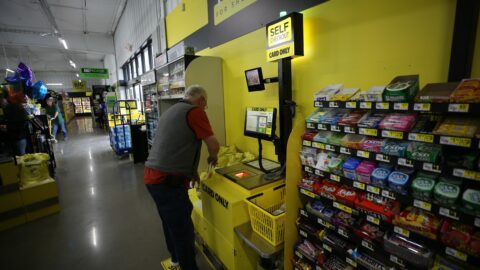Already a competitive advantage, cross channel capabilities are about to become an even more distinct differentiator with the arrival of mobile commerce. While both consumers and marketers have been slow to embrace mobile commerce in the U.S., several sources point to the channel arriving in a significant way over the next two years.
A new study from Foresee Results titled “Mobile Apps: The Next Big Thing” shows mobile applications will be impacting retail sales sooner than may executives expect, and those merchants already prepared for cross-channel commerce will have a distinct advantage. The study from Foresee shows a 91% penetration rate for mobile phone ownership, but only about a third of respondents have used them while shopping. Foresee CEO Larry Freed expects that usage to double by the end of 2009.
“And I would also say that the retailers who can merge channels have a definite advantage as that adoption rate continues,” Freed says. “As the situation has developed, consumers see definite advantages to the web experience in terms of information and inventory choices. And they see an advantage to the in-store experience, because it’s more personal and tangible. Mobile is the bridge between the two experiences.”
Freed is so bullish on the rapid acceleration of mobile usage for three reasons. First, he sees retailers making a priority of bringing the web experience into stores. Second, he believes competitive pressure will force their hand. And third, he expects the iPhone applications that started to appear in 2008 to become more commerce-oriented and less gimmicky.
During the 2008 season, the vast majority of shoppers who did use a mobile phone as part of their shopping experience did not use retailer-originated mobile apps or Internet-based product information. Most used their phone to get a simple opinion about a purchase. Freed says this may indicate that mobile apps are very much on the “bleeding edge,” rather than the leading edge, of technology.
One in four shoppers who used a mobile phone during a shopping trip used the device to compare prices, while 15% used a mobile device to go online to check product reviews. Freed says this is a significant number, considering the small but growing use of smart phones and the fact that many retailer mobile apps were new this holiday or still in beta testing.
One surprising fact that Freed uncovered from the Foresee study was that the emergence of mobile as a fourth channel could ultimately have more of an impact on brick and mortar shopping than online. “In fact, of all the behaviors we study, only one was different for this group: greater likelihood to purchase offline. All the other scores are identical for those who shop with or without a mobile phone. Given the indications that people are using phones more often to actually call someone to get an opinion or to send a picture of an item (and less for price comparison shopping or store-initiated mobile apps), it would seem that, more often than not, the opinion they get encourages them to buy the item. Perhaps stores should consider ‘phone-a-friend’ promotions to encourage this kind of shopping behavior.”
Freed councils retailers to encourage smart phone users to adopt retailer-generated mobile apps, not only to ask about a product or send a picture of a product to a friend, but to compare online prices, remember specs of something they were researching online, and identify the proper model or version of a wish list item.
MAKING MOBILE COLLABORATIVE
In a separate report on the emergence of mobile commerce, a team of executives from Cisco’s Internet Business Solutions Group (IBSG for Retail) presented their findings at the NRF Show in a Big Ideas Session titled, “Mobile as the Next Channel: Hype or Reality?” Jon Stine, IBSG, argued that retailers can no longer afford to ignore the internal and external benefits mobile devices bring.
“The productivity revolution that mobility represents has just begun,” said Stine. The smart devices we have, like the iPhone, will bring this to its height. “When consumers walk into a store and they are going to mobile applications to check prices and SKUs at other retailers, that other competitor has entered your store. In the past, retailers asked the consumer to come to their brand. Then we asked them to find our website. Now it is possible for a brand to go along with the consumer as a shopping buddy.” Mobility changes the paradigm. The numbers mobile can produce can and will be meaningful for those who prepare, according to Stine.
Arguing that mobile commerce is at a tipping point, Cisco’s IBSG Director Lisa Fretwell suggested retailers work closely with their customers on finding the most appropriate uses for mobile applications. By creating a collaborative experience out of the mobile channel, Fretwell pointed out that retailers have an opportunity to significantly increase margins.
Fretwell also reminded retailers that mobility is no longer limited to consumers; but some smart phone devices can increase store associate productivity for a two-way optimization of the device. “The mobile phone as a new channel is giving retailers a new way to position your brand to your shoppers,” she said. Stine notes the shift mobile devices have on the in-store experience. “Previously it was about getting consumers in your store, but now it’s about being with them 24/7 via their mobile devices,” he said. The mobile device enables information deliverability and harbors loyalty.
Fretwell pointed to three main opportunities for retailers to focus on in using the mobile channel:
- Productivity: By providing store employees access to information on a mobile device that they would have had to find manually, there are opportunities bottom line savings.
- Shopper productivity: Giving consumers access to tasks that previously could only be completed by store associates, such as self scanning for price checks provides convenience and reduces labor costs.
- Transforming the customer experience: New messaging channels provided by mobile devices are expected to have a dramatic impact on customer retention, and also provide new paths to increase basket size.
In order to get started tapping into the power of mobile devices, Stine suggested retailers focus on using mobility as an additional content source. “Be prepared to sell, but also be prepared to inform,”he said. The opportunity to inform consumers on the spot at point of purchase has just exponentially risen.”













